Quintagroup Analytics Tool for Plone
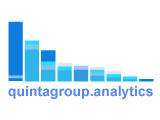
quintagroup.analytics package provides statistic information about Plone site, presented in few content stats views of Plone content workflow states, ownership and portlets registered on different contexts.
Links
- Home page - http://quintagroup.com/services/plone-development/products/quintagroup.analytics
- product on PyPi? - http://pypi.python.org/pypi/quintagroup.analytics
- Repository - http://svn.quintagroup.com/products/quintagroup.analytics
Introduction
Information provided by quintagroup.analytics allows you to see Plone site content from different perspectives. This information can be very useful while migrating your site into newer Plone version, or into another CMS.
With its help you can visually audit the content setup in Plone site before migration and compare it with the migrated website structure.
Requirements
Plone 3.x, Plone 4.0
Installation
quintagroup.analytics can be installed as a Python package by adding it to eggs section of a buildout and to the ZCML area:
[instance]
....
eggs =
....
quintagroup.analytics
recipe = plone.recipe.zope2instance
...
zcml =
quintagroup.analytics
Then Re-run buildout with:
$ ./bin/buildout
Restart the Zope server with the following command in the terminal:
$ ./bin/instance restart
Activate Quintagroup Analytics via Quickinstaller in Plone: Site Setup -> Add-ons.
Usage
To see your Plone site statistic information - navigate to Quintagroup Analytics item that appeared under Add-on Products Configuarion after package installation. Here you will see general info about the product and a list of available statistics.

Browse through all configlet tabs to see all statistic information, generated by Quintagroup Analytics Tool.
The following example screenshots were taken on a small website with 5 content contributors.
Content Ownership by Type
Information about most popular content types on your site. Here you can see the most frequently created content types on your site and their owners.
This chart displays the most frequently created content types in relation to their owners. Since we have only 5 content contributors - they are all listed here. If your site has much more content contributors - only 10 most active ones will be displayed. The same rule goes for content types. If there are additional products used on your site that brought custom content types - they can be listed here. 10 most popular content types will be displayed.
The table under the chart displays number of content objects of all site's content types in relation to their owners. Besides, the total number of created objects by every contributor is provided.
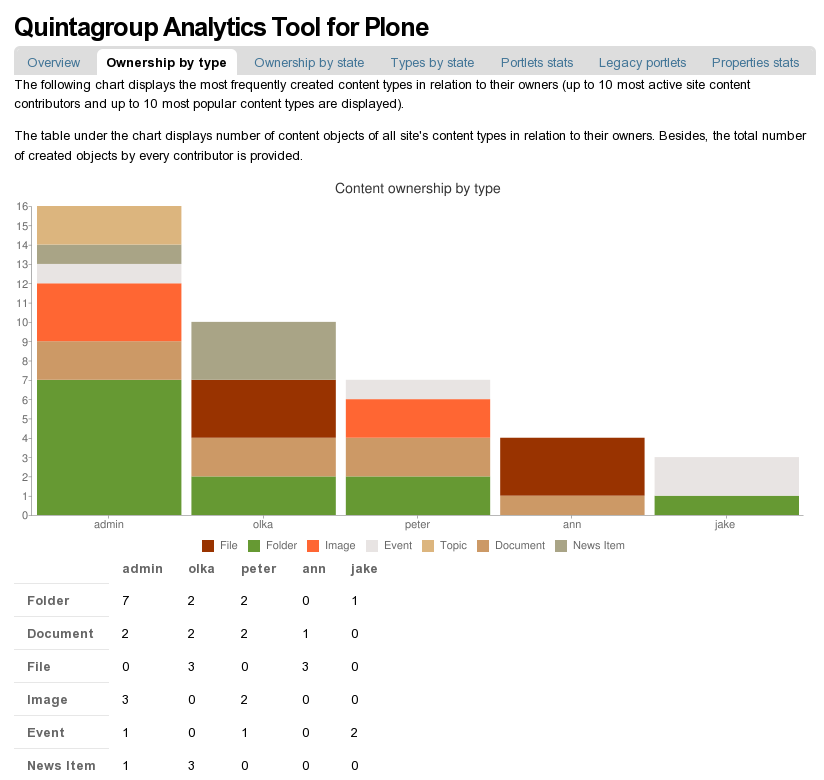
Content Ownership by State
Information about site's content workflow states. Here you can see how many content object are published/submitted for review/etc. and their owners.
This chart displays workflow states of site's content objects in relation to their owners. Up to 10 most active site content contributors can be displayed here as well.
The table under the chart displays number of content objects in all site's workflow states in relation to content owners.
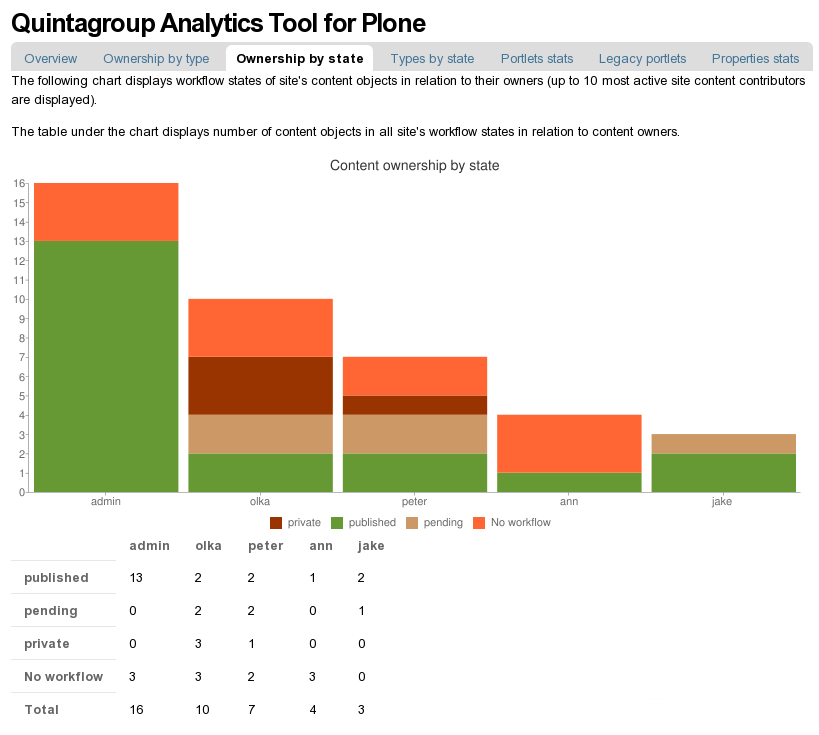
Content Types by State
This chart and table display workflow states of the site's most frequently created content types. You can see the total number of site's content objects of every content type.

Site Portlets
Information about site portlets, assigned to left and right columns on different contexts. To see your site's portlets - first specify the search depth: portlets on what level(s) to be included (here I types -1 that means all, no limits).
Now you can see all portlets assigned on your site and edit them: click on the porltet title to land on the portlet edit form.
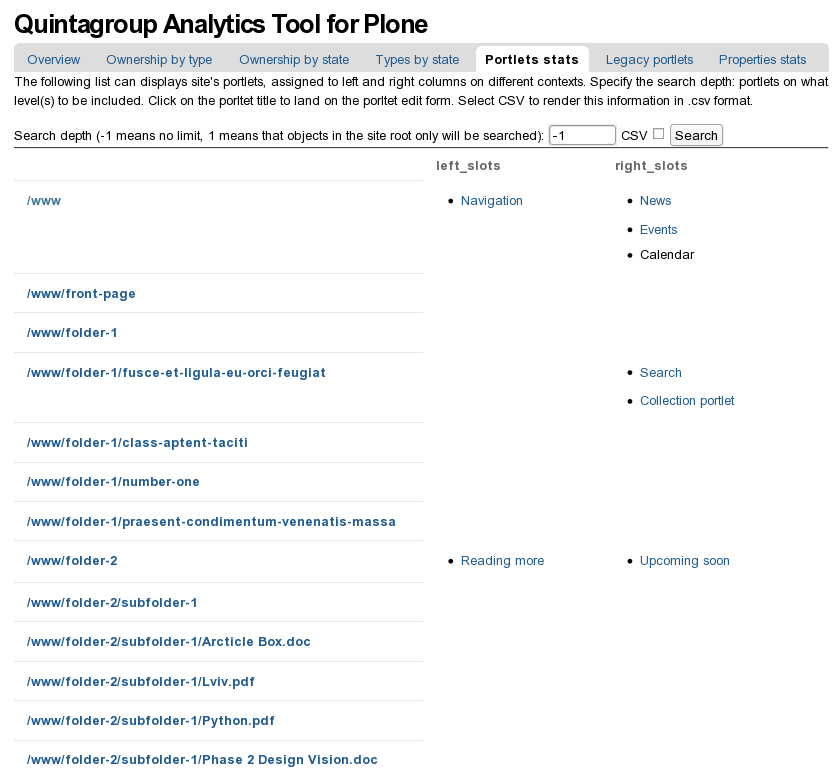
You can select CSV to render this information in .csv format.
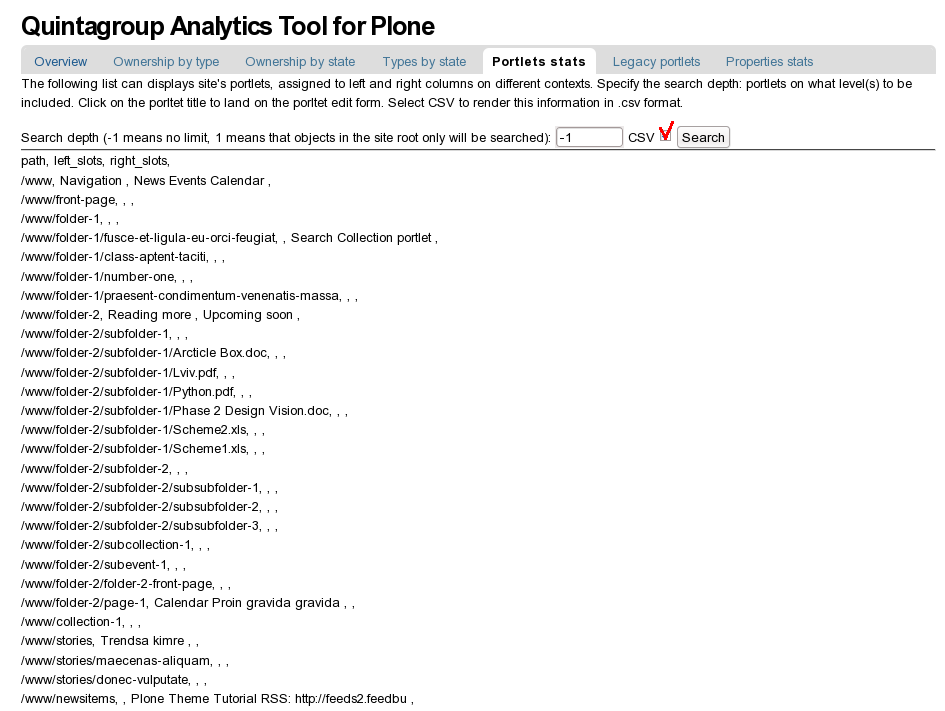
Legacy Portlets
Information about legacy assigned throughout site sections. This section works in the same way as Site Portlets.
Legacy porltets were used on previous Plone (e.g. Plone 2.x) when porltets were added as left and rigth slots to object properties. Since for example we took Plone 4 website - there are no legacy portets on it.
Properties Stats
Information displaying values for certain property for site objects. To generate the list - specify the search depth (objects on what level(s) will be included) and type in property name (a list of all available properties is provided below).
For example: to display all site objects titles we type '-1' into Search depth field and 'title' into Property name field.
You can select CSV to render this information in .csv format.

Attachments (8)
- by-state.png (41.2 KB) - added by olha 15 years ago.
- by-type.png (45.9 KB) - added by olha 15 years ago.
- portlets.png (57.2 KB) - added by olha 15 years ago.
- properties.png (69.6 KB) - added by olha 15 years ago.
- types-by-state.png (39.5 KB) - added by olha 15 years ago.
- overview.png (81.3 KB) - added by olha 15 years ago.
- portlets-csv.png (78.4 KB) - added by olha 15 years ago.
- qAnalytics_logo-160-120.jpg (13.5 KB) - added by olha 15 years ago.
Download all attachments as: .zip
![(please configure the [header_logo] section in trac.ini)](/trac/chrome/common/qtrac_logo.png)